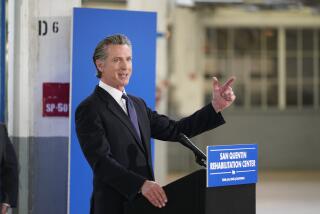Getting With the Program : Is gridlock being replaced by consensus?
- Share via
Is Washington finally getting the message? Quickly, almost magically, significant new spending cuts--well beyond those proposed by the White House--are on table in the Washington budget debate. Influential Democrats in the House have agreed to an additional $63 billion in deficit-reduction measures. The Senate Budget Committee is seeking even more--$90 billion in cuts.
Might American politics be in for a sea change as both voters and politicians go along with higher taxes and demand reduced government spending? The answer will emerge when a final budget clears Congress later this year. But Washington just might escape the usual gridlock. Finally.
The President’s economic plan has been mostly criticized for its paltry spending cuts--not, surprisingly, for its tax increases. Some of the cuts are also seen as politically safe. Last week, the Congressional Budget Office and Joint Committee on Taxation released new figures showing that proposed spending cuts and higher taxes in the President’s plan will fall more than $60 billion short of expected savings and receipts over the next five years. Deftly, Clinton indicated from the beginning that he would consider more spending cuts.
The House Budget Committee reached an agreement late Monday on a budget resolution that would reduce spending $63 billion across the board, a move intended to placate conservative Democrats pressuring for more cuts.
The reductions include capping outlays for discretionary programs at the current levels for the next five years and reducing cost-of-living increases for retired federal workers below the rate of inflation. Those cuts would get the deficit below $200 billion by 1997.
House Republicans are making a lot of noise about seeking even bigger cuts--almost 10 times as much as the Democrats--but they concede they do not have the votes to pass their plan. Meanwhile, Sen. Jim Sasser (D-Tenn), who heads the Senate Budget Committee, says his panel is seeking nearly $30 billion more in cuts. The two houses want to come up with a budget resolution by April.
The White House has indicated it can accommodate up to $55 billion in new spending without jeopardizing “public investment” programs that Clinton sees as central to his vision for America’s long-term economic vitality. Preserving that investment package is a top priority for the White House. Clinton warns that reducing the deficit too rapidly could endanger the recovery.
What appears to be emerging here is a genuine political consensus. When Clinton first unveiled his economic program in his address to Congress last month, more than one seasoned old pro in Capitol Hill looked on skeptically. But now more and more Americans--even legislators--are getting with the program. This is remarkable.
More to Read
Get the L.A. Times Politics newsletter
Deeply reported insights into legislation, politics and policy from Sacramento, Washington and beyond. In your inbox twice per week.
You may occasionally receive promotional content from the Los Angeles Times.









